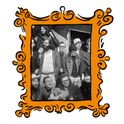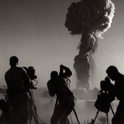
(Above) The PI doesn't solve mysteries with armchair deduction but by invading the private spaces of others
Often responding to Philip or Sam, the private investigator (PI) may be identified by his coat and hat. His natural habitat: the wet street corner or, unauthorised, another person’s home. He is commonly accused of committing the very crime under his investigation. You will find him lit starkly, from the side. He is good at getting women into bed, but they often turn out to be malevolent villainesses. He is American. The PI’s bloodlines flow deeply into the tradition of masculine heroes. His characteristics loom so large over Western popular culture that it can be hard to make him out. This is the problem facing any book on the film noir detective: being a chap, in a movie, trying to solve a problem, he is as inscrutably general a cultural trope as the femme fatale. What makes a PI a PI, and not just some other kind of leading man? You can’t even really chalk him up to an era, since he has existed since the early days of film. Bran Nicol’s new book,The Private Eye: Detectives in the Movies (Reaktion) gets some real purchase on our man. For a start, Nicol clears away the generic red herring of noir. Although many of the greatest PI movies are films noirs—The Big Sleep (1946), say—the PI is not a simple stand-in for this difficult genre, first formalised by Raymond Borde and Etienne Chaumeton in their classic 1955 study Panorama du film noir américain 1941–1953. Even Borde and Chaumeton acknowledged that their famous five film noir traits—oneiric, strange, erotic, ambivalent, and cruel—were neither clear cut nor all strictly necessary in order for a film to be noir. This genre is yoked together by a general ambience—an aura of darkness—rather than any true collective character. If the film noir is about one particular thing, I’d say it was about bad people. It is therefore about crime, and the investigators of those crimes. Enter the PI. Nicol’s book begins with a solid history of the origins of the private eye. PI movies include some of the classic American themes; the lone wolf, the suave seducer, the crusader after justice. As Nicol points out, however, the PI’s roots go deeper. Although Nicol’s references are distressingly limited to the outdated Northrop Frye, he brilliantly uncovers the links between the PI and chivalric heroes. It has long been my pet contention that Vertigo (1958) and the 14th century Middle English poem Sir Gawain and the Green Knight have the same plot, so you can imagine my delight at this passing comment. (Those uninterested in my Vertigo/Sir Gawain theory, or who wish to avoid spoilers, are advised to skip the next two paragraphs.) In Vertigo, one woman seems as if she is three women—Madeleine, Carlotta and Judy. Scottie, the protagonist, is on a quest to figure out what is really going on. He witnesses false deaths, follows false leads, quests under illusions. A shocking revelation starkly divides the film into two sections: the first section is radically, retrospectively realigned by the second. The girl was not the girl, the death was not the death. Every moment in which Judy/Madeleine establish their “identities” or shift between them is consistently coloured green. Green dresses, green jewellery, green lighting—even Madeleine's car is green. The performed death (which seems as if it is real) takes place in a chapel. In Sir Gawain and the Green Knight, one man seems as if he is two men—the Green Knight and Bertilak. Gawain, the protagonist, is on a quest to figure out what is really going on. He witnesses false deaths, follows false leads, quests under illusions. A shocking revelation starkly divides the poem into two sections: the first section is radically, retrospectively realigned by the second. The girl was not the girl, the death was not the death. Every moment in which identities are established or shifted features the Green Knight—who is, as you might expect, coloured green. Green skin, green hair: even his horse is green. The performed death (which seems as if it is real) takes place in a chapel. This reading (Jimmy Stewart and the Green Knight, if you will) may have to remain my pet, but I could kiss Nicol in advance for what I assume would be his total agreement. But back to what he actually discusses. Nicol is particularly good on the contrast between the classic armchair detectives of fiction and the more rugged heroes in the hardboiled crime fiction that provided the PI movie with its source material. Sherlock Holmes, C Auguste Dupin, Miss Marple, Hercule Poirot: these are indoor detectives, generally unacquainted with physical danger or, if sometimes, very seldom violently scathed. There is also a class difference—the PI is “hired by a bitch to find scum,” as Albert Graves says in the stylish late-noir Harper (1966), not by duchesses to find diamonds. Poirot is not routinely beaten and humiliated, left for dead in the street. He also never sleeps with the clientele. The movie PI has, therefore, two Achilles’ heels: vulnerability to fists and to ladies. Nicol is also smart in highlighting a lesser-known Edgar Allan Poe story: The Man of the Crowd (1840). His thoughts here on flâneur-ship, public versus private space, and the simple act of following somebody, point to a richer and more complex kind of literary heritage behind the PI character than is usually presumed. The PI really hit his stride in the movies of the 1940s onwards, and Nicol provides a useful taxonomy of the different eras that followed: classic PIs (1940s-59), second wave (late 1960s and 1970s), and postmodern, or neo-noir (late 1980s to the present day). The classic era is best understood via two characters: Raymond Chandler’s Philip Marlowe and Dashiell Hammett’s Sam Spade. Marlowe and Spade both grew out of the pulp-fiction genre and are thus rather similar: hard-drinking, witty, intelligent. Both were also played by Humphrey Bogart, who happened to be all those things in real life, too. In movies like The Maltese Falcon (1941), The Big Sleep, Murder, My Sweet (1944), and The Brasher Doubloon (1947), these two witty, trench-coat-wearing, workaholic men became mid-twentieth century icons. They are not interchangeable, however: Marlowe made excellent coffee, Spade did not. But there is room for variety with the classic first-wave PI. Almost every Hitchcock film—but especially Vertigo and Rear Window (1954)—features a PI of some sort or other. Elsewhere, The Dark Corner (1946) and Laura (1944) give us utterly solitary detectives, while Bogart’s Dix in In a Lonely Place (1950) is forever hanging around in the bar with his friends. I, The Jury (1953) and Kiss me Deadly (1955) turns their protagonist Mike Hammer bad to the bone, while Marlowe is essentially a good-boned hero. The second wave of the PI movie has to be seen in the light of the first. The Long Goodbye (1973) is one of the best, starring Elliot Gould as Philip Marlowe at his softest boiled—preoccupied with his cat, verging on professionally incompetent, almost unbearably, though shufflingly, sexy. Compare this Marlowe to Bogart’s Spade The Maltese Falcon. Along with The Big Sleep, Falcon is the pinnacle of the hardboiled PI type. It is filled with strangely soulless, all-surface characters, the glittering metal falcon at its centre daring the viewer to draw analogies between it and the characters who are hunting for it. Is the falcon the genuine article or a hoax? Whose goodness is only painted on, and whose is the real deal? Early 1940s San Francisco is full of stilted relationships and financial desperation, the movie’s central mystery mixing unreadable feminine duplicity with long, tangled strands of European myth (seriously, the Knights Templar?). By contrast, 1970s Los Angeles—home to the second wave PI—is sex-suffused, nihilistic, shambolic—old LA’s ruins, in other words, set to a drawling theme tune. The Long Goodbye has a dreamily declinist, even eschatological, aura to it. Near the film’s start, Gould wearily ignores a troupe of topless, dancing neighbours. It is a position that Bogart could never have found himself in. Both films, however, end with a big surprise, revealing the hero as a man who is somehow both totally inadequate and totally heroic. The first and second wave are thus connected by format, but the world has changed completely. The hero has changed a little, too. As Nicol says, the stars of the second wave (Jack Nicholson in Chinatown (1974), Robert Mitchum in Farewell, My Lovely (1975), Donald Sutherland in Klute (1971)) carry a more casual, sexy gravitas than their tortured predecessors. Their co-stars are complex sex symbols rather than inscrutable fatales—Faye Dunaway, Charlotte Rampling, Jane Fonda. Later, the PI took on its postmodern, or “hybrid” form. Hybrid PI movies pluck elements from the classic corpus to create a third form altogether: Blade Runner (1982) and Blue Velvet (1986) are the best of these, the latter of which Nicol discusses very well indeed. More straightforwardly “neo” detective films include Angel Heart (1987), Devil in a Blue Dress (1995), and 2005’s tremendous “high-school noir” Brick. The hybrid doesn’t have its own character. It repurposes and invents. In explaining all this, Nicol’s tone is that of the highbrow documentary presenter: scholarly, soberly-paced, but essentially keyed to keep your interest. Social-historical arguments are couched in theorists like Foucault and Jameson, who are so oft-cited today that Nicol’s use of them might strike certain readers as conventional. Even so, his handy wielding might prove a good entry point for readers whose curiosity is piqued. Well-chosen stills and quotations are interspersed throughout, including a nice selection of lines from Harper (highly recommended, incidentally, for its prominent use of Paul Newman). Which brings us, on the topic of magnetic leading men, to sex. Nicol’s central, flourishing argument is about public and private spheres: the idea that one can see literally with the private eye, in contradistinction to being seen in the public eye. By this, he means that there are ways in which people act when they imagine themselves to be open to the gazes of others—in “public”—and ways in which they act when they imagine themselves to be unseen—in “private”. The two conditions are Nicol’s two “eyes,” which he juggles into an interpretation of the term “private eye” itself. To appear in the private eye, Nicol suggests, “would mean, rather paradoxically, not being aware of being watched, feeling convinced that one is in private, and acting differently from the way one would in public.” So, in Chinatown, we see Hollis Mulwray through Jake Gittes’s binoculars or camera lens—caught in the private eye, unaware. Vertigo’s Madeleine doesn’t act in any remarkable fashion at first, but because we know she is being followed—seen in the private eye—“she becomes instantly foregrounded as a woman with something to hide or who has been subjected to a particular ordeal.” Nicol suggests that the PI exercises a particular kind of “private eye” looking, because he does not solve mysteries with armchair deduction but rather by invading the private spaces of others, often women, by watching them. We associate the noir detective with a no-bullshit attitude, an ability to see things exceptionally clearly and impartially. In fact, the PI’s way of looking is a murky one. It is less than a hop, skip or jump from mere watching to prurient voyeurism, and the gaze of the PI movie is inescapably masculine. LB Jeffries peeping through the pane in Rear Window; Jeffrey Beaumont in the cupboard in Blue Velvet; Harry Angel in Angel Heart. Chivalric sleuths or dull perverts? Nicol calls these “limit-case” private eye films, where the “viewer has an ethical responsibility…to look for the gaps between the gaze of the detective and the gaze of a more objective other.” Criticism with an ethical directive is most uncommon, and I like it. Nicol could have taken this issue of the PI’s distinctive sexuality a little further, I think. He barely grazes on the issue of masochism, which is an important aspect of the PI type. Lying, cheating, angel-faced, sweet-talking women thwart the PI’s entire life. In The Maltese Falcon, in In a Lonely Place, our hero is a walking broken heart. The trenchcoat is done up like that to hold in his guts. The PI’s wounded helplessness plays out, I think, in a sexuality characterised by covetous aggression but also by pulverised physical vulnerability. We see him beaten, over and over again. The violence of the PI film is totally unlike that of a bloody thriller, or a war movie. When Marlowe gets beaten up twice in The Big Sleep, we watch the virile leading man being tortured and we enjoy it. And so, deep down, does Marlowe. When the private eye inevitably antagonises the police, he certainly seems to be volunteering for a hiding. As with so much in film noir, the pain and the sex is mixed up. But we also enjoy it because the private eye movie is one of the great entertainment genres of the last century, and it isn’t quite dead yet. Nicol’s book will provide the seasoned noir-ist with more clues to hunt down, or introduce the curious novice to a new film universe. But in the end, only the films themselves will do. Nobody can explain who the PI is better than the PI himself. In Lady in the Lake (1947), Adrienne Fromsett pitches Marlowe’s story to a publisher and finds out exactly why detectives and writing don’t go together all that well:
Adrienne Fromsett: And he's a very well-known private detective. That's what makes the stuff so authentic. So full of life and vigor and heart. So full of... what would you say it was full of, Mr. Marlowe?
Philip Marlowe: Short sentences.
Follow Prospect on Facebook and Twitter If you enjoyed this article:Departing from reality: What do science fiction movies tell us about our own times? asks Alex ChristofiMaster of manipulation: Don't overinterpret Alfred Hitchock's films, says Malcolm Thorndike Nicholson—they are pure, undiluted spectacle Why I never use email: An anti-internet manifesto, by Terry Eagleton












